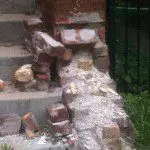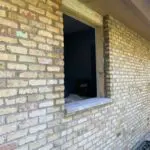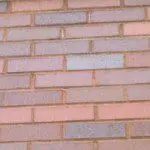11 Sep 2024
When is Lintel Replacement Necessary?

Unfortunately, unless you go to the trouble of having the mortar custom made to match, the repair will stick out like a sore thumb forever. Hire a a professional tuckpointer for a perfect match. Custom mortar is well worth the wait, as it will ensure a seamless repair.
What’s involved in lintel replacement?
The first step is to remove the bricks above the lintel. A replacement lintel should be installed that is galvanized to prevent rust. Proper flashing is also installed. Lastly the brick is reinstalled with weep holes above the flashing, allowing moisture to escape. Contact Shamrock Tuckpointing for an estimate on lintel replacement.
There is nothing worse than a brick repair that looks like a patch job. Cracks in brick are a concern and should be repaired for both structural and aesthetic reasons. But the repair shouldn’t look as bad or worse than the crack. The most common cause of a vertical crack in a brick wall is foundation settling. Before any repair is done, we have to ensure that the wall is on a solid base, so settling issues won’t cause similar problems down the road. This might require re-grading around the foundation or an evaluation of the drainage system around the building.
The second step of the repair is removing the cracked bricks. This is done very carefully so there is minimal damage to surrounding bricks. A chisel and hammer along with a masonry drill help slowly remove the affected brick and mortar.
Matching the brick and mortar is the key to an seamless repair. On a newer building, it is easier to match the brick exactly with the help of our brick suppliers. Older buildings can be a greater challenge, but almost anything is available through suppliers of salvaged brick. Another solution is to remove bricks from inconspicuous places to use in a highly visible repairs.
Mortar matching is an art, with the most important components being cement, and the type of sand used in the mortar. Other ingredients include include lime, Portland cement and dye. We typically test a few different samples, carefully measuring and recording the formulas. Experience tells us how the wet mortar will look after it cures, but we can also do some quick drying methods. We use the age of the building to guide us in determining the type of mortar.
Not all tuckpointing contractors will be as concerned as you are about brick and mortar matching. Make your expectations known at the outset, and check references. It’s the only way to ensure that a brick crack doesn’t turn into an even-worse looking repair.
30 Dec 2014
Brick Buildings Built to Last
 Brick Buildings Built to Last
Brick Buildings Built to Last
According to the International Association of Certified Home Inspectors (IACHI), brick buildings are built to last 100 years or more. Of course, that only happens with proper maintenance and normal wear and tear. Routine inspections help identify sources of leaks, damaged mortar and cracks.
But what about other components of a brick building: how long do they last?
Caulking: 5 to 10 years
The role of exterior caulking is to seal out moisture and outside air. This helps keep the inside cool or warm. This tight moisture barrier keeps rain and snow out of gaps and joints. Use caulking when window and door frames meet an exterior wall; when different types of materials meet; such as wood with brick; where siding meets the foundation, and where there are gaps in the masonry; or openings for ducts, plumbing or wiring. Over time caulking can harden and lose its flexibility, causing it to pull away from the surfaces it is adhered to. A visual inspection of your caulking can tell you if you need to replace yours, but most should last 5 to 10 years.
Waterproofing: 8 years
Waterproofing agents are often used on masonry chimneys to prevent damage. They are vapor permeable so the brick so that water vapors are allowed to escape. Several products have been developed specifically for use as waterproofing agents on masonry chimneys. These formulas are 100% vapor permeable, which means that they allow the chimney to breathe. Paint or clear sealers should never be used as a waterproofing agent because they will trap water vapors and moisture inside the chimney causing further deterioration.
Chimney crown (concrete): 100 years
The longest lasting chimney crowns are constructed of a Portland cement-based mixture and cast in a way that provides an overhang projecting beyond all sides of the chimney by a minimum of two inches. However, sometimes they are made out of far less durable mortar. When cracks appear in the crown it is time to replace it. Failure to replace a crown can result in far worse damage to a brick chimney.
Keep track of when you performed key maintenance tasks such as replacing caulking or waterproofing your chimney. Maintenance is the key to extending the lifecycle of your brick home or fireplace.
After this past Chicago winter, with all the snow and ice we experienced it’s important to inspect brick and masonry. Brick chimneys, parapet walls and roofs can be damaged by snow and ice. When high areas are involved its important to inspect brick safely. Every day, nearly 2,000 people are injured while using a ladder, and as many as 100 of them will suffer a long-term disability.
Please read these important ladder safety tips before you get on a ladder to inspect.
Select the Right Ladder to Inspect Brick Safely
Safety begins with the right ladder. Make sure the weight, level of usage and duty rating is meets the demands of the job. Type IAA, IA and I are the only acceptable ladders on a construction jobsite. If working near electricity, use a fiberglass ladder with non-conductive side rails. Metal ladders and wood ladders with metal reinforcement can conduct electricity. If the ladder is not he right length you might have to overreach to get the job done. That’s how accidents happen. When calculating the length, consider that an extension ladder consists of two overlapping sections, so a 16-foot ladder will actually have a maximum reach of 15-feet. OSHA requires that an extension ladder extend three feet over the roof or other working surface.
Prepare for the Climb
1. Check the Ladder
Before you start climbing, check aluminum ladders for sharp edges, dents, or bent steps, feet, rails, loose rivets or corrosion. Watch for cracks, chips and missing components on fiberglass ladders. Check the lanyard for signs of wear and fraying. Inspect the rungs, steps and foot friction pads for wear, missing parts or slippery substances. OSHA requires that defective ladders be immediately marked as defective and withdrawn from use until they are repaired.
2. Check the Site Conditions
Locate overhead wires. Be sure the distance to the nearest overhead line is twice the length of the ladder. If it’s windy, raining or a chance of lightning, don’t climb a ladder. If you need to position a ladder in front of a door or other location where it could be accidentally dislodged, be sure to lock the door, blockade it or assign someone to block it. Be sure to check that the ground underneath the ladder is level and firm. Use large flat wooden boards under the ladder as a level on soft or uneven ground.
3. Prepare Yourself
Wear non-skid footwear and dr your shoes before climbing. Carry tools in pockets, in a bag attached to a belt, or raise and lower them by rope.
Above all, stay safe. And if it turns out you do help with your brick and masonry maintenance please give us a call.

For example, a brick chimney with cracked mortar or a deteriorated chimney crown is a fairly minor repair. However, once masonry starts to deteriorate, the rate of deterioration grows exponentially.
Chicago’s freezing and thawing cycles work to turn small cracks into crevices, quickly. Other forces may be at work as well, including rusted metal adjacent the brick, incorrectly formulated mortar, and moisture trapped behind painted or improperly sealed brick.
Left unattended, minor masonry problems can result in not only an unsightly appearance, but also in an unsafe structure that could potentially collapse or prevent proper ventilation. In the case of a chimney, a total rebuild may be necessary. Lack of knowledge about brick maintenance has serious consequences.
Sometimes the source of a masonry problem isn’t always obvious. For example, water that enters through a cracked chimney crown can leak down and cause problems elsewhere. Similarly, water in the soil can also move upward through capillary action. A masonry repair professional is trained to diagnose the source of the problem and provide a permanent solution.
If you are concerned, contact us and we’ll come out and take a look. An early assessment may prevent structural failure later.




 Brick Buildings Built to Last
Brick Buildings Built to Last
